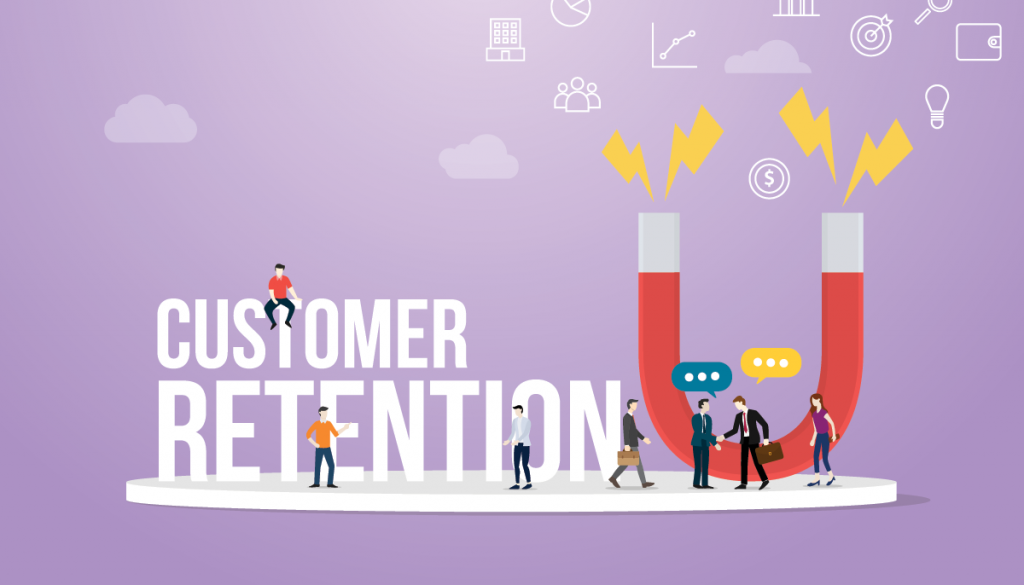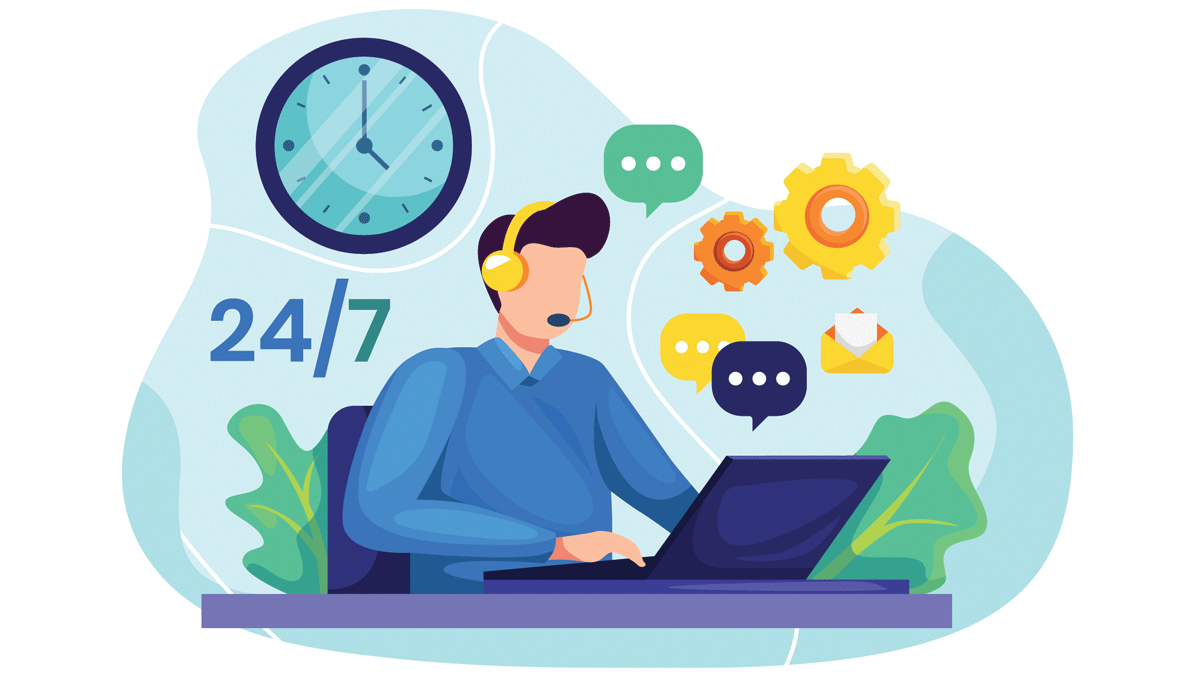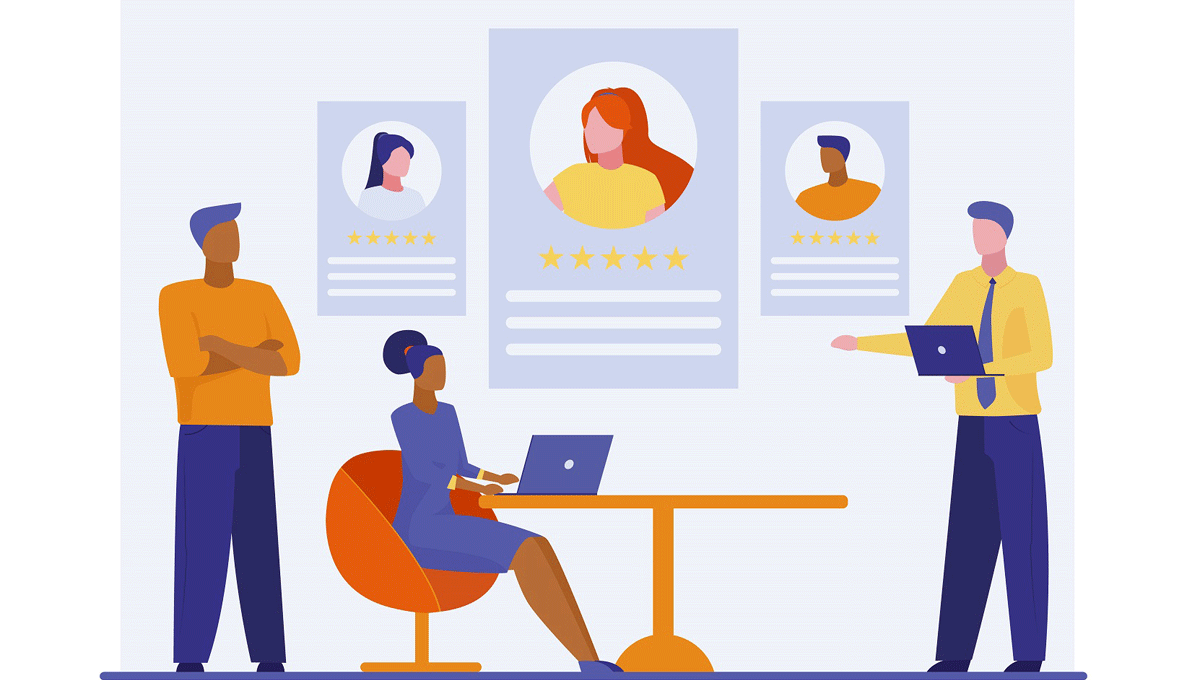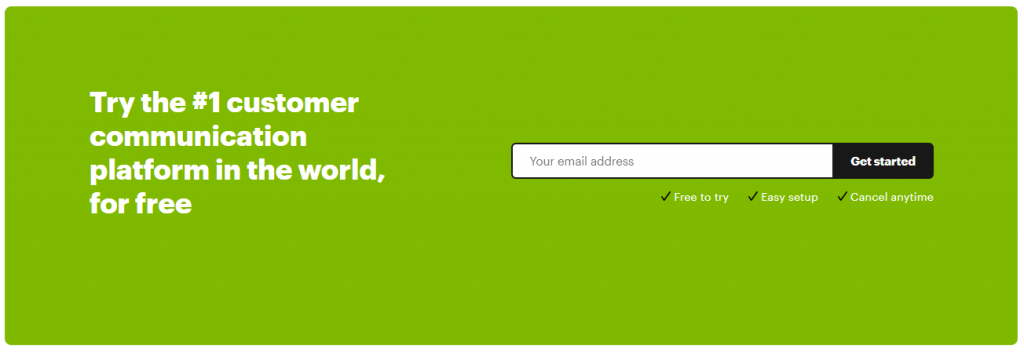Why you need to focus on retention rate?
What would you prefer…
Try and sell to a complete stranger?
or
Offer your product or service to someone who has already bought it before?
It seems obvious that selling to existing or past customers is far better than trying to cold sell to someone new. The relationship you have established with existing customers is what tips the scale and the numbers support it.
NG Data provides information that customer retention costs up to seven times less than selling cold or customer acquisition.
Not only this, but it is also faster. In some industries new leads go through a journey and marketing funnel that could last months if not even years, while up-selling to existing users can take a matter of days.
Still not convinced? According to a Huify article the chances of up-selling existing users ranges between 60 – 70%, while average conversion rates for new users are 5% – 20%.
Clearly focusing on your current users is a great strategy to increase your revenue.
But how are you supposed to know the exact actions you should take?
You should take into consideration the metrics and data in order to make an informed decision on your next actions. We must find pathways into user behavior that we can track, which gives us knowledge if the business is progressing in the right direction.
Correlate user behavior to find paths leading to retention
What kind of data do you need?
Some of the most important metrics you should track are CRR(Customer Retention Rate) and CLV(Customer Lifetime Value)
Let’s start with Customer Lifetime Value:
Customer lifetime value shows you how much your users are worth for your business. It takes into consideration the total revenue they generated from their first purchase until their last transaction.
Why should we track this metric? Because minor changes can lead to great impacts, hopefully positive…
Let’s show an example:
If you have 1,000 users paying you $50 per month and they stay with you on average for 10 months. That means your CLV is $500. Increasing the time they stay with you from 10 months to 12 months will bring another $100,000 revenue in your business.
Of course there is no way you could know this if you weren’t tracking this metric in the first place.
Let’s see how tracking Customer Retention Rate can benefit your business:
Having data on your customer retention rate is like flashing your headlights in the dark when you are driving. It shows you a bright picture if your company is going in the right direction.
Having such information will help you better prepare for the future and make strategic plans you can execute in order to drive more business growth.
CRR is a metric that will help you get insight into the effectiveness of the processes you use to keep current users happy. Said in other words these are your retention processes.
They start from the moment a customer had their first interaction and continue all the way into your future relationship after the sale. It is needless to say that CRR and CLV are greatly tied together. You can clearly see that improving your retention processes will lead to an increase in your CLV and overall revenue.
How do we measure CRR? The goal here is to find out what number of users stayed without counting the number of new onboarded users during a period of time.
The information you need:
- Number of users at the start of the period (S)
- Number of users at the end of the period (E)
- Number of newly acquired users during the period (N)
Formula: CRR = ((E-N/S) x 100
Example:
You start at 1,000 users (S) in January. You end at 1,100 users (E) in April. You added 200 new users(N) during that period.
CRR for first quarter = ((1,100 – 200) / 1,000) x 100 = 90%
Knowing this you can track how your yearly retention rates vary and if you need to take action before it results in a great loss or reputation damage.
It is very important to set proper benchmarks for your Customer Retention Rate. Falling under your company benchmark is a clear indicator that you should take action and improve your efforts.

User retention rates for different verticals
There are averages for different verticals that you can use to inform yourself if you’ve never tracked such metrics. Keep in mind that the benchmarks you set should always be specified for your company based on actual data not industry averages.
With that said let’s get a broad perspective so you can get on the right track.
Setting proper benchmarks. What can you expect from your CRR?
Of course, the best possible CRR is 100%. That would mean your company is growing without losing any customers. Yet you should look at a more realistic goal and aim at the range of 80 – 90 % for your business to continue to scale and grow strong.
Below are statistics provided in the 2018 NPS & CX Benchmarks Report that show the average customer retention rate across multiple industries.
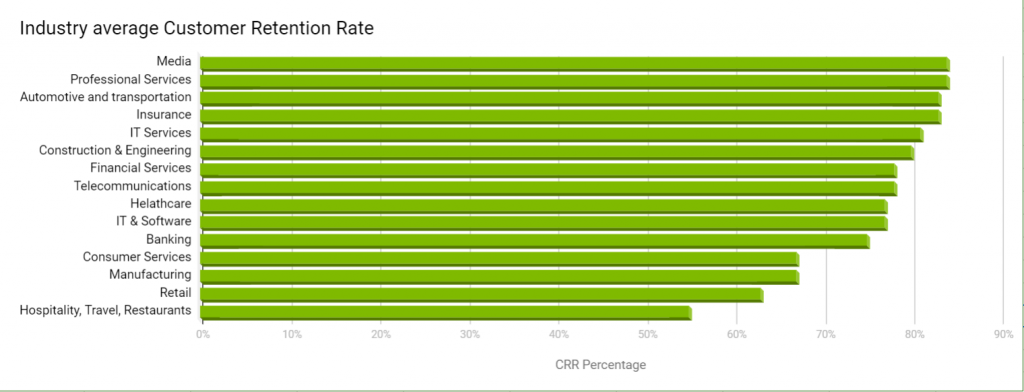
Methods for increasing user retention
If all you ever did was calculate some metrics and learn new information then nothing will change. You will see major changes in your organization only after you take action based on the information you gathered.
After we gather data and set proper benchmarks it is time to look deeper into the processes and take action. There are many ways in which you can approach your user retention activities, but we will focus your attention on just a few that will be enough to greatly impact your business.
We will outline 5 basic methods you can implement to increase user retention:
- Understand your user
- Value your user’s time, resources and privacy
- Reward loyal users
- Use good user engagement techniques – live chat
- Have robust customer support & user feedback process
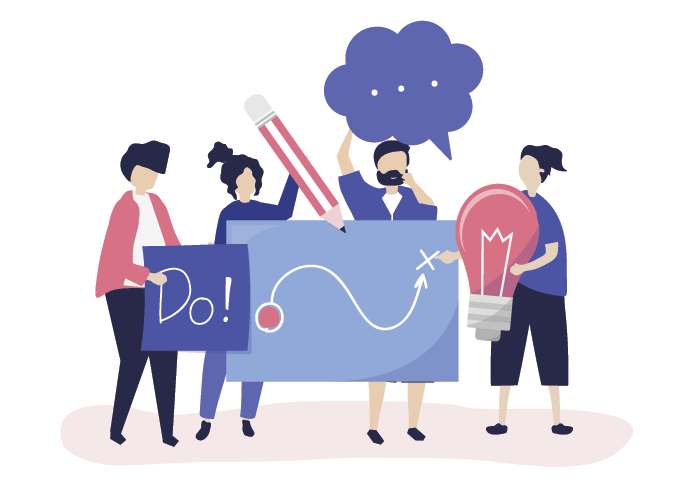
Understand your user
Your users started working with you because you solve an issue or problem and they had trust that you will hold to your word. From this point forward it is important to learn more about your current users and grow your relationship further.
How can we understand more about our users?
If only our customers just told us what they want and what their problems are it would be so much easier. Well, they actually can!
First, you need to define what you are looking to learn about your users.
- Are you looking for more information on their spending habits?
- What about the issues they faced in the past when looking for similar solutions to yours?
- How do they feel about your company at the moment?
When you know what you are searching for, asking the right questions is easy. You just need to find ways in which you can connect and exchange this valuable information.
There are many mediums that can help you with your user engagement process like:
- Customer quizzes
- Mobile App messaging
- Push notifications
- Interviews
- Social Media
- Ratings
Additionally you can combine feedback from your users with your own data that you get from analytical tools and see the bigger picture. Run A/B tests, search for patterns in customer behavior, create statistics on your demographics. Those are just some of the activities you can use to produce valuable information about your users.
Value your user’s time, resources and privacy
The information you know about your user will help you with all other initiatives. That way you can match all your actions with the user expectations.
Making your user the center of attention
Customers love when they are cared for and you give them the time they need to explain their situation. Empathy is a great skill to have in your future relationships with customers. That way you are more than an automated sequence of robotic steps or messages.
Showing empathy makes you an actual human that they feel comfortable to connect with and spend more of their time and money.
You are concerned with customers finances more than they are
It will often happen that users don’t know how much they should spend on a specific solution. You are the expert they turn to in need of help. You can choose to manipulate their perspective and charge a greater amount of money, but this will hurt your business in the long run.
Since the topic, today is how to keep customers happy and loyal then choosing the option to save their money and find a cost-effective solution will surely be something they will remember.
This will make you the go-to person for any other issue they have resulting in more revenue for your business long-term.
Make them feel safe about personal information
Users will share a lot of information with you like personal data, addresses, credit card details and more. You will have a lot of responsibility in your hands and you should choose wisely what to do with it.
If a user feels safe giving you personal information then that is a strong indicator that your business is creating the trust needed for a great relationship.
Even if we get a little annoyed when Google asks to confirm every time we login from a different device it still makes us feel safe about our information.
How can you implement similar initiatives in your company?
Reward loyal users
Let’s move in a different direction and see what we can do to transform regular users into loyal advocates and provide great customer service.
Why do we need to do that and what are the benefits for the business?
Regular users that turn into company advocates tend to spend more money, spend it more often and tell everyone how happy they are, meanwhile generating referrals. In this sense loyal customers can sometimes grow your business faster than your sales and marketing teams.
It sounds great but how can you apply a strategy for creating loyal company advocates?
Making users emotionally attached to your company.
Most often loyalty can be created by making your users more emotionally invested in the company itself.
Here are a few ideas on how to spark this emotion:
Implement a reward system
Every time a customer does a desirable action you can give them a reward. It can be a small discount, coupon code or another benefit. That way this action will be tied to the reward urging them to take action again.
Continue to give value even after the sale
You can provide free reports or other valuable information to users who stay with you after a certain period. That will show that they are valuable to you and keeps reinforcing your current relationship.
Show them that you care
Keeping in touch on a regular basis just to stay up to date is a great way to create loyalty. That way customers can see you are interested in them and will always showcase that in front of their friends and family. You can get creative by using app messaging or push notifications to automate the process but still stay top of mind.
Build a community
Social media, private groups and other ways of creating a community around your business are a sure way to boost loyalty. Even in your absence, your customers can talk to each other and create awareness of your business.
Personalize your interactions
It’s not just about addressing them with their name in the email or in a phone conversation. Try to make more touchpoints personalized and relevant to your customer.
For example:
Is your message tailored to the voice your customer is expecting? If you are serving a specific niche then you can use tailored terminology and jargon words in your copywriting.
Can you gather information about a customer birth date? Automate your systems to send greeting cards or push notifications to all the customers that have a birthday on a particular day.
The knowledge you have about your customers that was discussed in previous sections will greatly help you in personalizing your interactions and offered solutions.
Use good user engagement techniques – live chat
Users will sometimes reach out to get help or ask some questions. Make it easy for them by providing fast and reliable communication options. Trying to make it hard and hiding from them may save you some time in the short run, but this can lead to negative consequences.
Frustrated customers may not only stop paying but can also leave negative feedback and tell all their friends and family about the bad experience they had with the customer service.
What are the options for communication channels?
Technology offers a lot of flexibility when it comes to communication with customers. Push notifications, app messaging, website communication tools and many others.
One of the fastest-growing ways to communicate with users is through online mediums such as live chat. Studies have shown that customers love the convenience of connecting with your company in real-time directly from your website.
On the contrary they don’t like to wait for responses to chat messages and sometimes it takes a long time to resolve issues in a text chat, so often customers prefer a phone call.
We here at Live Chat Alternative have combined the best from both worlds. Our solution allows for instant online communication through your website without the need for text messaging.
The online user just clicks the button on your website and talks directly from their device free of charge from any country in the world. They don’t need to install any mobile app. You receive their call on your existing phone lines so there is nothing you need to change in your daily activities.
If you like to learn more about how we help businesses engage more with their customers while increasing sales and retention rates you can find more information here: Why use Live Chat Alternative / Live Chat Alternative Communication Software
Have robust customer support & user feedback process
A study from Lee Resources International showed that for every customer that complains about an issue there are 26 more who say nothing and just leave. This is why it is so important to have a proactive approach to customer support and feedback. That way you can spot issues when they arise and improve your retention rates.
In order to improve customer support and user experience then you need to turn to your data once more. First to understand what is the current situation and then to plan actions for improvement.
What metrics can you look for?
The basic calculations you can do are your Net Promoter Score(NPS) or Customer Effort Score(CES). Choosing the right metric comes from knowing what you want to learn.
- The Net Promoter Score will give insight into how likely customers are to recommend your business to someone. This NPS is more valuable if you want to improve your customer service and overall customer satisfaction.
How do you get this information?
Ask users to rate the likelihood of recommending your business from 0 to 10. Organize answers into Detractors(0 to 6) Passives (7-8) and Promoters(9-10). To determine your overall NPS just subtract the percentage of Detractors from the percentage of Promoters.
- The Customer Effort Score is more valuable if you are focused on improving your customer support and customer service. It shows how hard it was for customers with issues to reach a resolution.
Keep in mind that according to studies people who have a bad experience with a company are likely to share that experience with 10 more people.
The Bottom Line on Retention
It is clear that retaining customers can have a positive outcome on your business and revenue.
A research conducted by Frederik Reichchald( the person that invented the Net Promoter Score) shows that an increase in customer retention by 5% can increase revenue by 25% to 95%.
In order to achieve such results you should first look at your metrics and set proper benchmarks. Based on the gathered information you need to take action and implement systems for improvement.
There are different ways to implement new activities and they are always related to putting your customers first and improving your communication. You also need the right tools to make your efforts easier.
Lastly, you need to survey what impact you are making by tracking additional metrics like Net Promoter Score and Customer Effort Score.
If you like to learn more about increasing your retention rate and how you can improve your communication with customers than see our Live Chat Alternative pages.
We are also always ready to help and connect with you so feel free to reach out!
